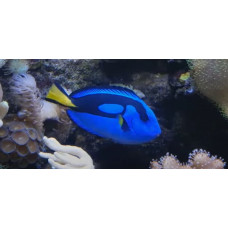Latin name
Paracanthurus hepatus
Other names
Regal tang, palette surgeonfish, blue tang.
Identification
The body is laterally compressed and ovoid in shape. This species is characterised by long dorsal and anal fins and a steeply sloping forehead. Large eyes provide excellent orientation in dark water. Anterolateral glandular groove containing a venomous gland.
Features of fish fins
Dorsal spines: 9; Dorsal soft rays: 19-20; Anal spines: 3; anal soft rays: 18-19.
Fish colouring
The body colour is dark blue with a prominent black pattern, the caudal fin is yellow.
Distribution
Widespread in the Indo-Pacific from East Africa to Japan and Samoa.
Habitat
Bentopelagic. Fish prefer to live on the outer slopes of coral reefs at depths of up to 40m between corals and in rock crevices.
Size
Body length ranges from 15 to 30 cm. Males are slightly larger than females.
Behavior
Fry live in flocks, adult fish live in pairs or singly. Life expectancy is 20 years.
Food and feeding habits
It feeds on both plankton and algae, which distinguishes it from most Acanthuridae.
Reproduction
Puberty begins at the age of two.
Fishing
No commercial value.
Relationship with a person
Popular aquarium fish. Poisonous.
| Classification | |
| Phylum | Chordata |
| Class | Actinopterygii |
| Squad | Acanthuriformes |
| Family | Acanthuridae |
| Genus | Paracanthurus |
| Species | P. hepatus |
| Features | |
| Conservation status | Least Concern |
| Habitat | Pelagic |
| Life span, years | 20 |
| Maximum body weight, kg | No information |
| Maximum length, cm | 30 |
| Sailing speed, m/s | No information |
| Threat to people | Not edible |
| Way of eating | Planktonophage |
Paracanthurus
Tags: paracanthurus



